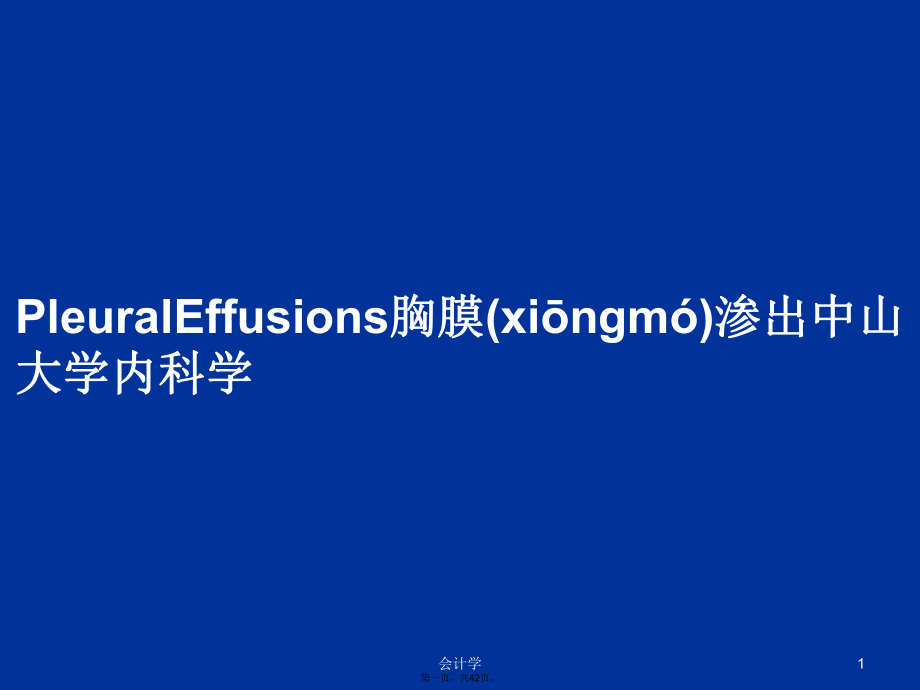 PleuralEffusions胸膜渗出中山大学内科学学习教案
PleuralEffusions胸膜渗出中山大学内科学学习教案



《PleuralEffusions胸膜渗出中山大学内科学学习教案》由会员分享,可在线阅读,更多相关《PleuralEffusions胸膜渗出中山大学内科学学习教案(42页珍藏版)》请在装配图网上搜索。
1、会计学1PleuralEffusions胸膜胸膜(xingm)渗出中山渗出中山大学内科学大学内科学第一页,共42页。2Dr. Canmao xie第1页/共41页第二页,共42页。 The pleural space is not really a space but rather a potential space between the lung and chest wall. It is a crucial feature of the breathing apparatus since pleurae serves as a coupling system between the lu
2、ng and chest wall.Introduction3Dr. Canmao xie第2页/共41页第三页,共42页。nThere is normally a very thin layer of fluid (from 2 to 10 m thick) between the two pleural surfaces, the parietal pleura and visceral pleura. The pleural space and the fluid within it are not under static conditions. n During each respi
3、ratory cycle the pleural pressures and the geometry of the pleural space fluctuate widely. Fluid enters and leaves the pleural space constantly . 4Dr. Canmao xie第3页/共41页第四页,共42页。Anatomy of the Pleural SpaceDr. Canmao xie5SC: Systemic capillaries PC: Pulmonary capillaries 第4页/共41页第五页,共42页。Dr. Canmao
4、xie6SC: Systemic capillaries PC: Pulmonary capillaries 第5页/共41页第六页,共42页。Figure 1. Anatomy of the pleural spaceSC: Systemic capillaries PC: Pulmonary capillaries 7Dr. Canmao xiestomasstomaselectronic microscopy第6页/共41页第七页,共42页。Figure 2. pleural fluids turnoverPF enter the pleural space through pariet
5、al & visceral pleurae,And leave pleural space through lymphatics in parietal pleuraDr. Canmao xie第7页/共41页第八页,共42页。 The passage of protein-free liquid across the pleural membranes is dependent on the hydrostatic and oncotic pressures across them. When the capillaries in the parietal pleura are consid
6、ered, it can be seen that the net hydrostatic pressure favoring the movement of fluid from these capillaries to the pleural space is the systemic capillary pressure (30cm H2O) minus the negative pleural pressure (-5cm H2O) or 35cm H2O. Opposing this is the oncotic pressure in the blood (34cm H2O) mi
7、nus the oncotic pressure in the pleural fluid (5 cm H2O), or 29cm H2O. The resulting net pressure differences of 6 cm H2O (35-29) favors movement of fluid from the parietal pleura into the pleural space. Mechanism of pleural fluids turnover9Dr. Canmao xie第8页/共41页第九页,共42页。Parietal Pleura VisceralPleu
8、ra Space PleuraHydrostatic Pressure +30 - 5 + 24 35 29 6 0Net 29 29 + 34 + 5 +34Oncotic Pressure10Dr. Canmao xie第9页/共41页第十页,共42页。11Dr. Canmao xie第10页/共41页第十一页,共42页。12Dr. Canmao xie第11页/共41页第十二页,共42页。Dr. Canmao xie13第12页/共41页第十三页,共42页。Dr. Canmao xie第13页/共41页第十四页,共42页。15Dr. Canmao xie第14页/共41页第十五页,共42
9、页。Physical ExaminationslDecreased or absent tactile fremitus, dullness to percussionlDiminished breath sounds over the site of the effusion lBronchial breath sounds are frequently present immediately above the effusion16Dr. Canmao xieBronchial breath soundsDiminished breath sounds第15页/共41页第十六页,共42页。
10、17Dr. Canmao xie第16页/共41页第十七页,共42页。18Dr. Canmao xie第17页/共41页第十八页,共42页。Dr. Canmao xie19第18页/共41页第十九页,共42页。20Dr. Canmao xie第19页/共41页第二十页,共42页。21Dr. Canmao xie第20页/共41页第二十一页,共42页。n Cloudy or turbid - either cells and debris or high lipid levelsPost centrifugation If supernatant turbid, due to high lipi
11、d levelsTurbid supernatant - measure pleural fluid triglyceride levelTriglyceride level 110 mg/dl chylothoraxTriglyceride level 250mg - pseudochylothorax50 mg/dl Triglyceride level 0.5 nPleural fluid LDH/serum LDH 0.6 nPleural fluid LDH 2/3 upper normal limit for serum LDH23Dr. Canmao xieDr. Light r
12、aised the Lights criteria when he was at age of 32LDH=lactate dehydrogenase第22页/共41页第二十三页,共42页。24Dr. Canmao xie第23页/共41页第二十四页,共42页。25Dr. Canmao xie第24页/共41页第二十五页,共42页。26Dr. Canmao xie第25页/共41页第二十六页,共42页。27Dr. Canmao xie第26页/共41页第二十七页,共42页。28Dr. Canmao xie第27页/共41页第二十八页,共42页。29Dr. Canmao xie第28页/共41页
13、第二十九页,共42页。30Dr. Canmao xie第29页/共41页第三十页,共42页。31Dr. Canmao xie第30页/共41页第三十一页,共42页。患者男性,患者男性,65岁。岁。因因“反复胸痛反复胸痛5月,呼吸困难月,呼吸困难(h x kn nn)1月,加重月,加重1周周” 入院。胸入院。胸水水CEA增高。增高。镜下见:脏、壁层胸膜镜下见:脏、壁层胸膜(xingm)间粘连带形成,壁层胸膜间粘连带形成,壁层胸膜(xingm)、膈面见、膈面见弥漫性结节样新生物,部分表面覆盖白色坏死组织,右上叶后段斜裂缘见白色弥漫性结节样新生物,部分表面覆盖白色坏死组织,右上叶后段斜裂缘见白色息肉
14、样肿物,右下叶表面多发灰色斑状浸润。病理示腺癌。息肉样肿物,右下叶表面多发灰色斑状浸润。病理示腺癌。第31页/共41页第三十二页,共42页。Pleural fluid markers for tuberculosis 33Dr. Canmao xie第32页/共41页第三十三页,共42页。34Dr. Canmao xie第33页/共41页第三十四页,共42页。35Dr. Canmao xie第34页/共41页第三十五页,共42页。36Dr. Canmao xie第35页/共41页第三十六页,共42页。37Dr. Canmao xie第36页/共41页第三十七页,共42页。38Dr. Canmao xie第37页/共41页第三十八页,共42页。39Dr. Canmao xie第38页/共41页第三十九页,共42页。40Dr. Canmao xie第39页/共41页第四十页,共42页。41Dr. Canmao xie第40页/共41页第四十一页,共42页。NoImage内容(nirng)总结会计学。因“反复胸痛5月,呼吸困难1月,加重1周” 入院。镜下见:脏、壁层胸膜间粘连带形成,壁层胸膜、膈面见弥漫性结节样新生物,部分表面覆盖白色坏死组织,右上叶后段斜裂缘见白色息肉样肿物,右下叶表面多发(du f)灰色斑状浸润。41第四十二页,共42页。
- 温馨提示:
1: 本站所有资源如无特殊说明,都需要本地电脑安装OFFICE2007和PDF阅读器。图纸软件为CAD,CAXA,PROE,UG,SolidWorks等.压缩文件请下载最新的WinRAR软件解压。
2: 本站的文档不包含任何第三方提供的附件图纸等,如果需要附件,请联系上传者。文件的所有权益归上传用户所有。
3.本站RAR压缩包中若带图纸,网页内容里面会有图纸预览,若没有图纸预览就没有图纸。
4. 未经权益所有人同意不得将文件中的内容挪作商业或盈利用途。
5. 装配图网仅提供信息存储空间,仅对用户上传内容的表现方式做保护处理,对用户上传分享的文档内容本身不做任何修改或编辑,并不能对任何下载内容负责。
6. 下载文件中如有侵权或不适当内容,请与我们联系,我们立即纠正。
7. 本站不保证下载资源的准确性、安全性和完整性, 同时也不承担用户因使用这些下载资源对自己和他人造成任何形式的伤害或损失。
